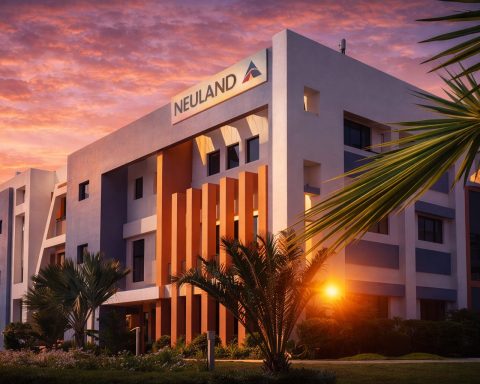By News Desk | November 28, 2025
A nation‑building power and broadband corridor into Canada’s Arctic took a major step forward this week, as Manitoba Hydro confirmed it is reviewing a formal request to deliver clean electricity and high‑speed fibre to five Nunavut communities in the Kivalliq region. [1]
The request comes on the heels of a new announcement from Inuit‑owned Nukik Corporation, which revealed key milestones in advancing the Kivalliq Hydro‑Fibre Link (KHFL) — including regulatory certification that clears a pathway to connect Nunavut to the North American grid for the first time. [2]
What happened this week
On November 4, Nukik Corporation formally filed a Transmission Service Request (TSR) with Manitoba Hydro. The filing asks the utility to study how up to 150 megawatts (MW) of renewable hydroelectric power could be transmitted from northern Manitoba into Nunavut’s Kivalliq region via a new long‑distance line. [3]
Manitoba Hydro confirmed this week that it has begun detailed technical and commercial studies in response to the TSR, officially launching its review of the proposed extension of its transmission grid and an integrated fibre‑optic cable roughly 1,200 kilometres north. [4]
At almost the same time, Nukik publicly announced:
- The TSR filing with Manitoba Hydro
- An agreement in principle on key commercial terms with Qulliq Energy Corporation (QEC), Nunavut’s territorial utility
- Its recent certification by the Midcontinent Independent System Operator (MISO), one of North America’s major regional transmission organizations [5]
Together, those moves shift the KHFL project from concept into a more concrete development phase, with utilities, regulators and governments now formally at the table.
What is the Kivalliq Hydro‑Fibre Link?
The Kivalliq Hydro‑Fibre Link is an Inuit‑led proposal to build a new 1,200‑kilometre transmission line with an integrated fibre‑optic cable from northern Manitoba to the Kivalliq region of Nunavut. [6]
Key project specs, according to Nukik Corporation’s latest backgrounder, include: [7]
- Transmission capacity: up to 150 MW of renewable hydroelectric power
- Data capacity: about 1,200 Gbps of fibre bandwidth
- Connected communities:
- Arviat
- Whale Cove
- Rankin Inlet
- Chesterfield Inlet
- Baker Lake
- Route: linking Nunavut to Manitoba’s grid near Churchill, creating a strategic connection to the Port of Churchill and broader trade routes
The project is designed to replace costly, diesel‑based generation in the region with firm hydro power while simultaneously bringing high‑speed broadband to communities that currently rely on slower, satellite‑based internet. [8]
Manitoba Hydro’s role: reviewing a new Arctic energy corridor
For Manitoba Hydro, the TSR triggers a structured process that examines whether — and how — its system can support a new export corridor into Nunavut.
According to Manitoba Hydro’s spokesperson, the utility is now evaluating the technical and commercial implications of extending its network 1,200 km north, in what would be one of its most ambitious export projects since the Birtle transmission line into Saskatchewan. [9]
The application being reviewed would:
- Deliver up to 150 MW of renewable power from Manitoba to Nunavut
- Use an integrated fibre‑optic cable to carry broadband services alongside the power line
- Create a new revenue stream for Manitoba Hydro through long‑term power sales
Because the request is still at an early stage, Manitoba Hydro has stressed that it is too soon to provide detailed answers about system impacts, costs, or required infrastructure upgrades. The current review phase focuses on modeling, system reliability, and commercial feasibility. [10]
A $3 billion Inuit‑led energy corridor
Nukik Corporation’s CEO, Anne‑Raphaëlle Audouin, has pegged the total project cost at around $3 billion, with a financing model that leans heavily on private investment and project revenues backed by federal partnership rather than Manitoba ratepayers. [11]
Key financing and governance details include:
- Ownership & leadership:
- Nukik is 100% Inuit‑owned, jointly controlled by Sakku Investments Corporation and the Kivalliq Inuit Association (KIA). [12]
- Federal support:
- Ottawa has already committed $14.4 million for development‑phase work, including engineering, design and environmental studies. [13]
- Projected cost:
- Total capital costs are estimated at $3 billion, with revenues expected from long‑term electricity sales and broadband services. [14]
The project’s leadership highlights this structure as a way to maximize private capital, keep Manitoba’s domestic hydro rates insulated from the project’s cost, and create a long‑term revenue stream for both Manitoba and Inuit owners. [15]
Why the Kivalliq project matters for Nunavut communities
For the five Kivalliq communities targeted by the link, the project promises a fundamental shift in daily life and long‑term development.
1. Replacing diesel with clean hydro
Most Nunavut communities rely heavily on diesel generators for electricity — a system that is costly, emissions‑intensive, and vulnerable to fuel price shocks and supply disruptions.
The KHFL would enable those communities to transition to renewable hydroelectric power, cutting greenhouse gas emissions and reducing the risks associated with diesel shipments. [16]
2. High‑speed broadband for Canada’s Arctic
By stringing fibre along the transmission corridor, the project aims to bring urban‑standard broadband to communities that currently face slow, expensive connections. Nukik describes the line as a “power and communications backbone” for northern industries and public services. [17]
That connectivity is expected to:
- Improve access to telehealth and remote education
- Support Arctic research, emergency response and local governance
- Enable digital businesses and remote work opportunities in the North
3. Economic growth and jobs
Manitoba’s Finance Minister Adrien Sala has framed the project as a win–win: creating construction and long‑term jobs while expanding export revenues for Manitoba Hydro. [18]
For Nunavut, the corridor is expected to:
- Lower operating costs for mines and future resource projects, especially in “strategic mineral regions” highlighted by project proponents [19]
- Attract new investment by providing reliable power and modern digital infrastructure
- Enable local ownership of a major national asset through Nukik and its Inuit shareholders
Climate, critical minerals and Arctic sovereignty
Project supporters consistently describe the KHFL as more than just an energy deal — they cast it as a cornerstone of Arctic sovereignty and climate leadership.
In its background materials, Nukik argues that the link will: [20]
- Cut emissions by displacing diesel generation
- Make northern communities more resilient to climate change
- Support development of critical minerals important to clean‑tech supply chains
- Strengthen Canada’s presence in the Arctic through permanent infrastructure tied to a deep‑water port at Churchill
Earlier in 2025, the governments of Manitoba and Nunavut signed a joint statement supporting an “energy corridor to Canada’s North,” explicitly naming the Kivalliq Hydro‑Fibre Link as a priority and committing to work with First Nations to protect lands, waters and caribou habitat. [21]
That framing — combining Indigenous ownership, climate policy, and sovereignty — is part of why proponents describe the project as a once‑in‑a‑generation “nation‑building” initiative.
MISO certification: Nunavut’s pathway to the North American grid
One of the most technically significant developments announced this week is Nukik’s certification as the first Arctic electricity developer in North America to be recognized by the Midcontinent Independent System Operator (MISO). [22]
MISO oversees a large chunk of the North American grid in the U.S. Midwest and parts of Canada. Certification signals that:
- The project is being developed within a recognized continental transmission framework
- Nunavut has a clearer regulatory pathway to integrate with broader North American power markets
- KHFL is being designed to meet modern reliability and market standards
For a territory that has never been physically connected to southern Canada’s grid, that step is both technically and symbolically important.
Timelines: from studies to construction
While excitement is building, the KHFL remains at the development and review stage.
According to project documents and recent reporting: [23]
- 2025–2027: Technical studies, environmental assessments, regulatory reviews, and commercial agreements
- 2028: Earliest anticipated start of construction, subject to approvals and financing
- 2032: Targeted completion of the line and fibre network
Between now and any construction start, the project must clear multiple hurdles:
- Manitoba Hydro’s system and commercial evaluation of the TSR
- Territorial and federal environmental assessment processes
- Final agreements with Qulliq Energy Corporation and other partners
- Secured financing and definitive federal commitments
Political and technical questions: cost overruns and capacity
Not everyone is convinced the project will be straightforward.
Progressive Conservative Leader Obby Khan in Manitoba has raised concerns about potential cost overruns, pointing to Manitoba Hydro’s past experience with the Bipole III transmission line, which roughly doubled from initial estimates to around $5 billion. [24]
Khan has also questioned:
- How Manitoba Hydro will find the additional 50 MW committed to Nunavut at a time when internal forecasts suggest the province will need new dependable power sources by around 2030 [25]
- Whether any cost risks could ultimately fall back on Manitoba ratepayers despite assurances from project proponents
These critiques underscore a broader debate: how to balance Manitoba’s domestic energy needs with new export opportunities, even when those exports could generate long‑term revenues for the province.
Who’s around the table
The KHFL now brings together a wide coalition of Indigenous, public and private partners, including: [26]
- Nukik Corporation – Inuit‑owned project proponent
- Sakku Investments Corporation and Kivalliq Inuit Association (KIA) – owners of Nukik
- Qulliq Energy Corporation (QEC) – Nunavut’s public power corporation
- Manitoba Hydro – provincial utility and transmission provider
- Government of Nunavut and Government of Manitoba
- Nunavut Tunngavik Inc. (NTI) – representing Inuit rights under the Nunavut Agreement
- Canada Infrastructure Bank – providing advisory support and potential financing
- Agnico Eagle Mines – major mining player in the Kivalliq region
This mix of partners is central to the project’s branding as an Inuit‑led but nationally supported corridor.
What to watch next
As of November 28, 2025, the Kivalliq Hydro‑Fibre Link stands at a pivotal moment:
- Manitoba Hydro has formally started its review of the transmission service request.
- Nukik and QEC have aligned on commercial principles and are working through detailed agreements. [27]
- Federal and territorial partners are under pressure to translate early funding and political statements into long‑term commitments.
Over the coming months, key signals to watch will include:
- Findings from Manitoba Hydro’s technical studies — particularly around system capacity and required upgrades.
- Regulatory filings and environmental assessment milestones in both Manitoba and Nunavut.
- Further federal announcements on Arctic infrastructure, clean electricity investment and support for Inuit‑led projects.
- Community consultations and impact benefit discussions with Inuit and First Nations along the corridor.
If those pieces come together, the Kivalliq Hydro‑Fibre Link could become one of the most consequential infrastructure projects in modern Canadian history — delivering clean power, high‑speed internet and a new measure of sovereignty to the Arctic, under Indigenous ownership, by the early 2030s.
References
1. www.winnipegfreepress.com, 2. nukik.ca, 3. www.winnipegfreepress.com, 4. www.winnipegfreepress.com, 5. nukik.ca, 6. nukik.ca, 7. nukik.ca, 8. nukik.ca, 9. www.winnipegfreepress.com, 10. www.winnipegfreepress.com, 11. www.winnipegfreepress.com, 12. www.sakkuinvestments.ca, 13. www.winnipegfreepress.com, 14. www.winnipegfreepress.com, 15. www.winnipegfreepress.com, 16. nukik.ca, 17. www.winnipegfreepress.com, 18. www.winnipegfreepress.com, 19. nukik.ca, 20. nukik.ca, 21. www.winnipegfreepress.com, 22. nukik.ca, 23. www.winnipegfreepress.com, 24. www.winnipegfreepress.com, 25. www.hydro.mb.ca, 26. nukik.ca, 27. nukik.ca










